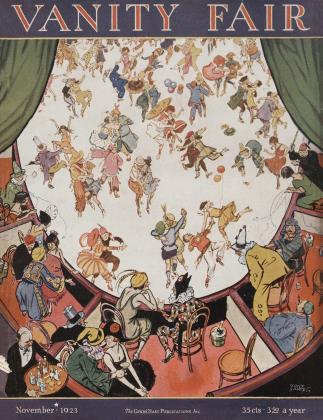Sign In to Your Account
Subscribers have complete access to the archive.
Sign In Not a Subscriber?Join NowEuropean Motoring
Front Wheel Brakes and Superchargers Engage Attention
C. S. BISS
UNQUESTIONABLY, the outstanding feature of 1924 motor car design in Europe will be the introduction of many new systems of front wheel brakes. In France, four wheel brakes are already supplied with approximately 75 per cent of the cars, but in England and in other parts of Europe where automobile manufacture is carried on to any great extent, this modern innovation has not made such great progress. All the preparations now being made for the international motor exhibitions at Paris and London strengthen the conviction that front wheel braking will be the big engineering development of the year.
In motoring circles, it would seem that four-wheel brakes are the sole topic of conversation; and in every issue of the technical press references are made to this subject. One thing which has held back the introduction of such brakes has been the fact that manufacturers have had to dispose of their 1923 cars. These were not equipped with front wheel brakes, and in consequence the makers have been reticent in discussing the question. On the other hand, those car builders who have already brought their products up to date are extraordinarily active in impressing their merits upon the public.
It is amusing to read the views against the introduction of four-wheel brakes, as expressed in the correspondence columns of the technical press. It recalls forcibly the positive assertions of those who entered the public prints at the time of the introduction of the 6-cylinder engine. At that time, the opposition was vigorous to the point of bitterness. Yet, the six cylinder is today one of the most popular types, and in July 6-cylinder cars were driven to victory in the Grand Prix race, the world's greatest automobile contest. Generally speaking, all modern motor car improvements are the outcome of practical experience gained in racing, two notable exceptions being the 6-cylinder engine and the electrical engine starter. However, four-wheel brakes arc not an exception, although I can recall that they were fitted to the Argyll car, a Scottish product, some years before the war, and on the Isotta-Fraschini as far back as 1910.
The British motoring world is justly proud of the great success of the Sunbeam team of racers in the French Grand Prix, although we fully appreciate the bad luck which snatched victory from the grasp of Salamano, in the Fiat, when victory for him seemed so near, A flying stone, a broken petrol tank, and his machine was stranded so far from the replenishing pits that, despite the valiant endeavors of his mechanic, he could not get going again before his rivals had passed him and finished the race. Very great credit is due to Sunbeam, whose team of three was the only team to complete the race. The Fiat team was, undoubtedly, the fastest in the field. Bordino was timed over the circuit at 87 miles per hour, and over a selected 300 metre stretch at 122 miles per hour. The winner's average for the entire race was 75 miles per hour. This was not so very fast, of course, but all
the drivers complained that the road was dangerous for .very high speed, and the surface went badly to pieces, The Sunbeam engines were six cylindered, with practically no novel features; with only two valves per cylinder, with magneto ignition, and only one carburetor for each engine. The Fiats were of eight cylinders, also with two valves per cylinder; but were fitted with superchargers which, no doubt, accounted for their extraordinary speed. In each case, the engines were reported as turning over at 6000 r.p.m., a truly phenomenal speed, Supercharging is an engineering matter which will attract much attention during the coming months. It is a method of forced induction of motor fuel, and is the latest device of the automotive engineers to extract more power from a limited cylinder capacity. Its merits have been conclusively proven by the Fiats in the Grand Prix. It would seem now only a question of time before the principle is embodied in general motoring practice. The Mercedes engineers, satisfied with their racing experience and their experimental work, have actually incorporated the idea into their touring cars, and we have seen in England an example of their newlitre touring car, so fitted. In this model the supercharger is brought into action at the will of the driver, whereas in the Fiat racer the supercharger is in operation all the time. Engineers recommend that the supercharger should not be allowed to operate until a fairly good speed has been attained. On a flat surface, an increase in speed of from 15 per cent to 20 per cent is obtained by the use of this device. In hill climbing a greater increase still is
noted, while in tests of acceleration, the increased power is phenomenal,
If we ventured to prophesy, we would predict the ultimate introduction of forced induction and the elimination of the carburetor as we know it today.
 View Full Issue
View Full Issue











Subscribers have complete access to the archive.
Sign In Not a Subscriber?Join Now